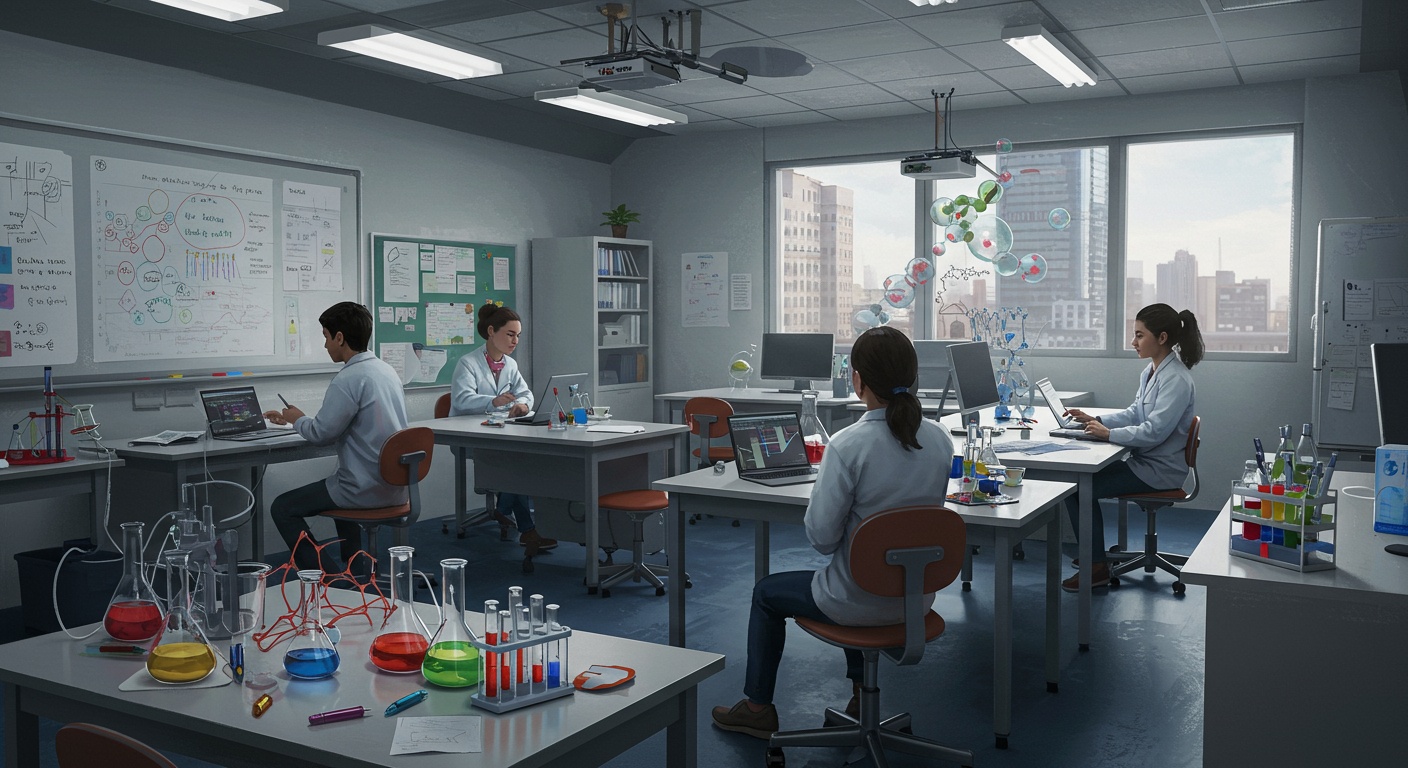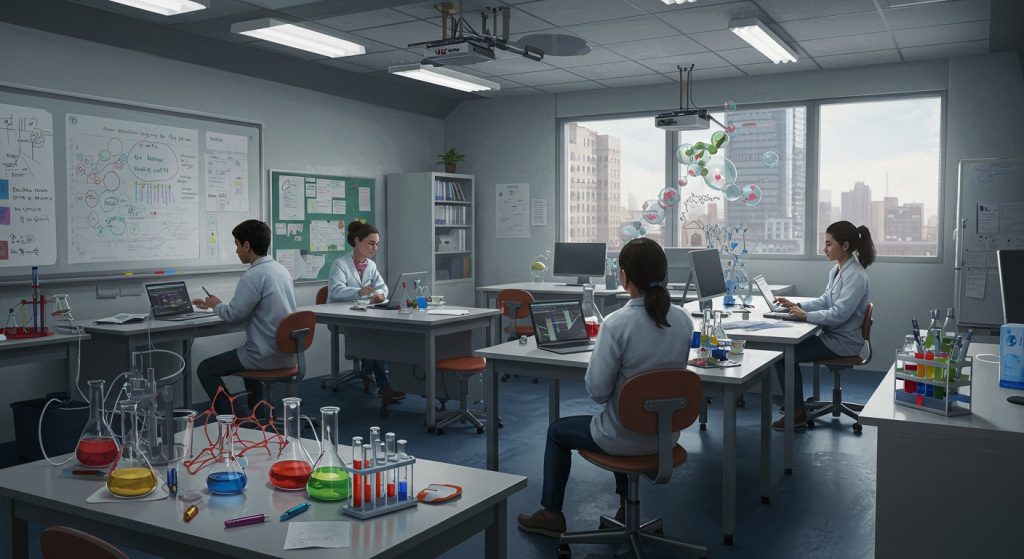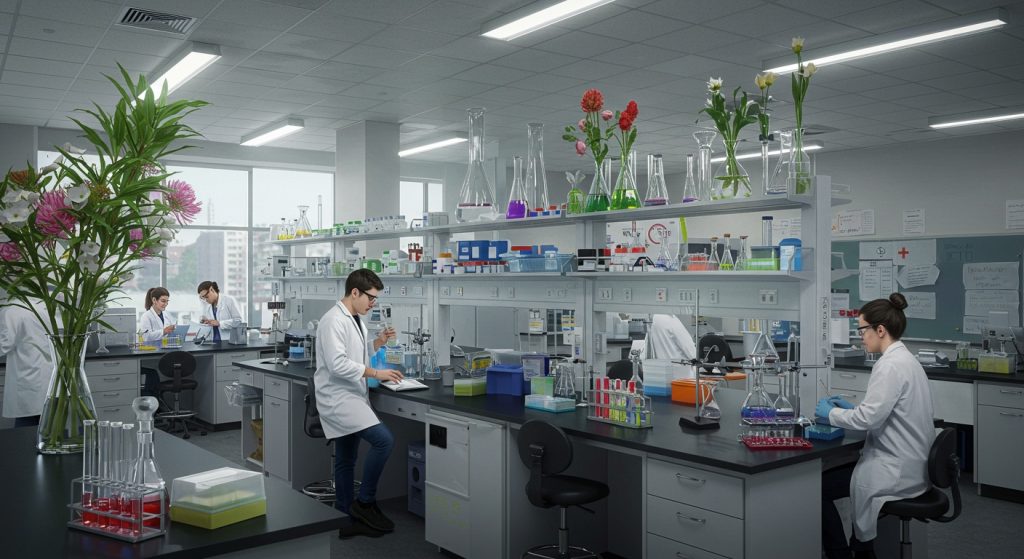Biotechnology stands at the forefront of scientific innovation, with recent breakthroughs in CRISPR-Cas9 gene editing and advanced multi-omics profiling rapidly transforming medicine and sustainable solutions. Aspiring biotechnology students today have an unparalleled opportunity to contribute meaningfully through their capstone projects, moving beyond conventional approaches to tackle pressing global challenges. Consider designing novel synthetic biology platforms for bio-manufacturing sustainable alternatives to petroleum-based products, or leveraging AI-driven bioinformatics to accelerate drug discovery for neurodegenerative diseases. From developing next-generation CRISPR-based diagnostics for infectious diseases like COVID-19 to engineering microbial systems for targeted plastic degradation, these projects empower students to shape future research trajectories and drive tangible impact in an ever-evolving bio-economy.

The Essence of a Biotechnology Capstone Project
For students immersed in the dynamic world of Biotechnology, the capstone project serves as the culminating academic experience. Far more than just a final assignment, it’s an opportunity to synthesize years of learning, apply theoretical knowledge to practical problems. Often, contribute a novel piece of research or a unique solution to a real-world challenge. Think of it as your scientific fingerprint, showcasing your expertise and passion.
A capstone project in Biotechnology typically involves an independent research endeavor, a design project, or the development of a prototype. It demands critical thinking, problem-solving skills. A deep understanding of scientific methodologies. Students are expected to define a problem, design experiments, collect and examine data. Present their findings, much like a professional scientist or researcher would. This process not only solidifies their academic foundation but also hones essential skills for their future careers in industry, academia, or further study.
Navigating the Cutting Edge: Key Trends in Modern Biotechnology
To conceive truly innovative capstone projects, it’s crucial to comprehend the major waves currently shaping the Biotechnology landscape. This field is constantly evolving, driven by technological advancements and pressing global needs. Here are some of the most influential trends that offer fertile ground for groundbreaking research:
- Genomic Engineering (CRISPR and Beyond): The ability to precisely edit DNA and RNA has revolutionized medicine, agriculture. Fundamental biology. Projects in this area could explore therapeutic applications, crop improvement, or even novel gene drive systems.
- Synthetic Biology: This field focuses on designing and building new biological parts, devices. Systems, or re-designing existing natural biological systems for useful purposes. Think programmable cells, biosensors, or novel metabolic pathways.
- Bioinformatics and Computational Biology: With the explosion of biological data (genomic, proteomic, metabolomic), computational tools are indispensable. AI and machine learning are transforming how we review complex biological systems, predict drug interactions, or identify disease biomarkers.
- Advanced Biomanufacturing: The use of biological systems (e. G. , microbes, cell cultures) to produce materials, chemicals, or pharmaceuticals at scale. This includes areas like cultured meat, sustainable materials. Recombinant protein production.
- Personalized Medicine and Diagnostics: Tailoring medical treatments to individual patients based on their genetic makeup, lifestyle. Environment. This trend is heavily reliant on advanced diagnostic tools and biomarker discovery.
- Environmental Biotechnology: Leveraging biological processes to solve environmental problems, such as bioremediation of pollutants, sustainable energy production (biofuels). Waste valorization.
Innovative Capstone Project Ideas: Bridging Theory and Practice
Now, let’s dive into some specific, forward-thinking project ideas that can truly make a mark. These concepts integrate current trends and address significant challenges, offering rich opportunities for exploration in Biotechnology.
1. Genomic Engineering & Gene Therapy Innovations
The precision offered by technologies like CRISPR-Cas9 opens vast possibilities for therapeutic interventions and fundamental research. A capstone project in this domain could involve:
- Targeted Gene Therapy for Rare Diseases: Designing and validating a gene editing strategy (e. G. , base editing, prime editing) to correct a specific pathogenic mutation associated with a rare genetic disorder like Cystic Fibrosis or Huntington’s disease in a cellular model. This would involve selecting appropriate guide RNAs, designing donor templates. Assessing editing efficiency and specificity.
- CRISPR-Based Diagnostics: Developing a novel, rapid. Low-cost diagnostic platform using CRISPR-Cas systems (e. G. , SHERLOCK or DETECTR) for detecting specific pathogens (e. G. , SARS-CoV-2 variants, antibiotic-resistant bacteria) or cancer biomarkers.
- Enhancing Crop Resilience through Gene Editing: Investigating the genetic modification of staple crops (e. G. , rice, corn) to improve resistance to specific pests, diseases, or environmental stressors (e. G. , drought, salinity) using CRISPR, potentially evaluating success in controlled greenhouse environments.
Real-world application: Companies like Intellia Therapeutics and CRISPR Therapeutics are already advancing CRISPR-based therapies through clinical trials for diseases like sickle cell anemia, demonstrating the immense potential of such research.
2. Synthetic Biology & Biomanufacturing for a Sustainable Future
Synthetic biology allows us to engineer biological systems from the ground up or re-engineer existing ones for novel functions. Projects here often have significant industrial and environmental implications.
- Engineered Microbes for Sustainable Bioproduction: Designing and constructing a microbial cell factory (e. G. , E. Coli or yeast) to produce a high-value chemical, biofuel (e. G. , biobutanol), or bioplastic precursor (e. G. , PHB) from renewable feedstocks or waste streams. This involves metabolic engineering and pathway optimization.
- Development of Novel Biosensors: Creating genetically engineered bacteria or yeast that act as biosensors to detect specific environmental pollutants (e. G. , heavy metals, pesticides) or disease markers (e. G. , glucose levels in diabetics, specific tumor metabolites) with high sensitivity and specificity.
- Cultured Meat/Alternative Protein Production Optimization: Investigating methods to optimize cell proliferation, differentiation, or scaffold design for the efficient and scalable production of cultured meat or other alternative protein sources. This could involve exploring novel bioreactor designs or growth media formulations.
Example: The production of artemisinic acid, a precursor to the antimalarial drug artemisinin, in engineered yeast by Amyris, showcases the power of synthetic biology in biomanufacturing.
3. Bioinformatics & AI in Biotechnology Research
The vast amounts of data generated in modern biological research make bioinformatics and artificial intelligence indispensable. These projects are often computational but can have profound biological implications.
- AI-Driven Drug Discovery and Repurposing: Developing machine learning models to predict potential drug candidates, identify novel drug targets, or repurpose existing drugs for new therapeutic applications by analyzing large biological datasets (e. G. , protein structures, gene expression profiles, chemical libraries).
- Personalized Medicine Predictive Models: Building computational models that integrate genomic data, patient clinical records. Lifestyle factors to predict individual patient responses to specific treatments or their susceptibility to certain diseases.
- CRISPR Guide RNA Design and Off-Target Prediction: Creating or improving bioinformatics tools and algorithms to design highly efficient and specific guide RNAs for CRISPR gene editing, while accurately predicting and minimizing off-target effects. This is crucial for therapeutic safety.
Case Study: AlphaFold, developed by DeepMind, revolutionized protein structure prediction using AI, demonstrating the transformative power of computational approaches in Biotechnology.
4. Advanced Biomedical Devices & Diagnostics
Developing innovative tools for health monitoring, disease diagnosis. Treatment delivery is a cornerstone of medical biotechnology.
- Point-of-Care Diagnostic Device for Infectious Diseases: Designing and prototyping a low-cost, rapid. Portable diagnostic device for detecting common infectious diseases (e. G. , influenza, dengue, strep throat) in resource-limited settings. This could involve microfluidics, biosensors, or lateral flow assays.
- Wearable Biosensors for Continuous Health Monitoring: Exploring the development of novel wearable devices that can continuously monitor specific biomarkers (e. G. , lactate, cortisol, glucose) from sweat, tears, or interstitial fluid, providing real-time health insights.
- Biocompatible Scaffolds for Tissue Engineering: Designing and fabricating novel biocompatible and biodegradable scaffolds (e. G. , using 3D printing) for tissue regeneration applications, such as bone, cartilage, or skin. Evaluating their cellular compatibility and mechanical properties.
Real-world impact: Companies like Abbott and Roche continually innovate in diagnostics, showcasing the demand for accessible and accurate medical devices. The rise of continuous glucose monitors (CGMs) for diabetes management is a prime example of wearable biosensor success.
5. Environmental Biotechnology & Bioremediation
Addressing global environmental challenges through biological solutions is a growing and vital area within Biotechnology.
- Microbial Bioremediation of Polluted Sites: Isolating and characterizing novel bacterial or fungal strains capable of degrading specific environmental pollutants (e. G. , crude oil spills, plastic waste, heavy metal contamination) and optimizing conditions for their bioremediation activity.
- Algae-Based Carbon Capture and Bioproducts: Investigating the potential of microalgae or macroalgae for efficient carbon dioxide capture from industrial emissions, coupled with the production of valuable bioproducts like biofuels, bioplastics, or high-value pigments.
- Sustainable Waste Valorization: Developing biotechnological processes to convert agricultural waste, food waste, or municipal solid waste into valuable resources, such as biogas, compost, or microbial proteins for animal feed.
Expert Insight: Dr. Craig Venter’s work on synthetic genomics, including efforts to engineer microbes for biofuel production, highlights the potential of biotechnology for sustainable energy solutions.
6. Agricultural Biotechnology & Food Security
Biotechnology plays a critical role in enhancing food production, improving nutritional value. Ensuring global food security.
- Developing Drought-Tolerant or Disease-Resistant Crops: Applying genetic engineering or advanced breeding techniques to enhance the resilience of staple crops against adverse environmental conditions or prevalent plant diseases, crucial for regions affected by climate change.
- Enhancing Nutritional Content of Food Crops: Investigating biotechnological approaches (e. G. , biofortification through genetic modification or microbial symbionts) to increase the vitamin, mineral, or protein content in common food crops to combat malnutrition.
- Precision Agriculture through Microbiome Engineering: Exploring the manipulation of plant root microbiomes to improve nutrient uptake, enhance plant growth, or reduce the need for chemical fertilizers and pesticides. This could involve inoculating plants with beneficial microbes.
Use Case: Golden Rice, engineered to produce beta-carotene (a precursor to Vitamin A), is a well-known example of how Biotechnology can address nutritional deficiencies in vulnerable populations.
Choosing Your Capstone Path: Actionable Advice
Selecting the right capstone project is a critical decision. Here’s how to approach it strategically:
- Identify Your Passion: What areas of Biotechnology genuinely excite you? Your enthusiasm will be a major driver through the challenges.
- Align with Faculty Expertise: Seek out professors whose research aligns with your interests. Their guidance and resources will be invaluable.
- Address a Real Problem: The most impactful projects often tackle existing challenges, whether in medicine, agriculture, or the environment.
- Consider Feasibility: Be realistic about the time, resources (equipment, reagents, computational power). Skills required. A smaller, well-executed project is better than an ambitious but incomplete one.
- Think About Future Career Goals: Does this project align with the type of work you want to do after graduation? It can be a powerful resume builder and talking point in interviews.
- Interdisciplinary Potential: Biotechnology often thrives at the intersection of fields (e. G. , biology, engineering, computer science, chemistry). Don’t shy away from projects that bridge disciplines.
Tip: Attend departmental seminars, read recent publications in journals like “Nature Biotechnology” or “Science,” and engage with professionals in the field to identify emerging research gaps and potential project ideas.
Navigating the Challenges: What to Expect
Undertaking a capstone project in Biotechnology is a rewarding but challenging journey. Here are some common hurdles and how to prepare for them:
- Experimental Failures: Science often involves trial and error. Be prepared for experiments not working as expected. This is a learning opportunity, not a failure.
- Data Analysis Complexity: Biological data can be vast and complex. Strong analytical skills, often involving bioinformatics tools, are crucial.
- Time Management: Capstone projects require significant time commitment. Develop a detailed timeline and stick to it.
- Resource Limitations: Access to specific equipment or reagents can sometimes be a constraint. Plan ahead and discuss needs with your supervisor.
- Ethical Considerations: Especially in areas like gene editing or human health, be aware of and adhere to ethical guidelines and regulations.
Recommendation: Maintain a detailed lab notebook or digital record of all your experiments, observations. Thought processes. This is invaluable for troubleshooting and writing your final report.
The Impact of Your Biotechnology Capstone: Shaping Future Research and Careers
Your capstone project is more than just a grade; it’s a testament to your capabilities and a potential springboard for your future. A well-executed project can:
- Open Doors to Graduate Studies: Demonstrates your research aptitude and readiness for master’s or Ph. D. Programs.
- Enhance Employability: Provides practical experience that employers highly value, differentiating you from other candidates. It shows initiative, problem-solving skills. Deep domain knowledge.
- Contribute to Scientific Knowledge: Even small-scale projects can yield novel insights or preliminary data that can be published or lead to larger research initiatives.
- Build a Professional Network: Working closely with faculty, postdocs. Lab mates on your project can create valuable connections.
- Foster Innovation: Your project might spark new ideas, methodologies, or applications that contribute to the broader field of Biotechnology.
By investing thoughtfully in your capstone project, you’re not just completing a requirement; you’re actively shaping your future as a scientist, innovator. Contributor to the exciting world of Biotechnology.
Conclusion
The capstone project in biotechnology is far more than a mere academic requirement; it’s your launchpad into shaping future research. To make it truly impactful, choose a project that genuinely excites you and aligns with current scientific frontiers. For instance, exploring novel CRISPR applications in gene therapy or leveraging AI for accelerated drug discovery, mirroring recent breakthroughs, can truly set your work apart. My own experience taught me that tenacity and cross-disciplinary collaboration are invaluable. Don’t shy away from projects that seem ambitious, such as developing sustainable bioplastics from algal biomass – a critical area in green biotechnology. Seek out mentors, network with industry professionals. Stay rigorously updated on journal publications. This proactive approach transforms a daunting task into a profoundly rewarding journey of discovery. Your capstone is a unique chance to contribute meaningfully to biotechnology’s evolution. Embrace the challenge, innovate fearlessly. Remember that every experiment, successful or not, refines your scientific acumen. Go forth and shape the future!
More Articles
Get Real-World Ready: Experiential Learning Opportunities at Public Universities
Ensuring Excellence: Accreditation and Quality in State University Programs
Ace Your College Life: Balancing Academics and Social Success
Beyond the Diploma: Exciting Career Paths for State University Alumni
FAQs
What exactly is a capstone project for biotechnology students?
It’s a major, independent research project that you undertake typically in your final year. It’s where you get to apply all the knowledge and skills you’ve gained, often by tackling a real-world problem or exploring a cutting-edge area in biotechnology.
Why is it vital to have innovative ideas for these projects?
Innovative ideas are key because they push the boundaries of current knowledge. They can lead to novel solutions, new discoveries, or even new applications that haven’t been explored yet. Plus, it makes your project stand out and demonstrates your creativity and forward-thinking approach to future employers or grad schools.
Can you share some examples of innovative biotech capstone project ideas?
Absolutely! Think along the lines of using CRISPR for sustainable agriculture, developing AI models for personalized drug discovery, designing bio-sensors for early disease detection, engineering microbes for plastic degradation, or creating novel bio-manufacturing processes for lab-grown meat alternatives. The possibilities are vast and often interdisciplinary.
How do I come up with a truly unique and innovative idea?
Start by identifying gaps in current research or exploring emerging technologies. Read recent scientific papers, attend seminars. Talk to your professors about their ongoing work or challenges in the field. Look for areas where biotechnology intersects with other disciplines like computer science or engineering. Don’t be afraid to think outside the box!
What kind of impact can a successful innovative project have on my career?
A well-executed innovative project can significantly boost your career prospects. It showcases your research skills, problem-solving abilities, critical thinking. Capacity for independent work. This makes you a more attractive candidate for competitive jobs or advanced degree programs. It could even be the foundation for a startup or patent.
Do these projects always require a lab, or can some be computational?
Not at all! While many biotech projects are lab-based, an increasing number of innovative ideas are purely computational. This includes bioinformatics projects, developing machine learning algorithms for biological data analysis, creating simulations of biological systems, or designing computational models for drug interactions. It really depends on your specific interest and the resources available.
How do I choose the right project for me, considering my interests and future goals?
Picking the right project is crucial. Reflect on which areas of biotechnology excite you the most – is it genetics, pharmaceuticals, environmental biotech, or something else? Consider your strengths, the resources available at your institution. The expertise of potential faculty mentors. Choose something you’re passionate about, as that enthusiasm will fuel your work through the challenges.



